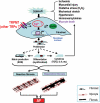Molecular determinants of cardiac fibroblast electrical function and therapeutic implications for atrial fibrillation
- PMID: 20962103
- PMCID: PMC3039247
- DOI: 10.1093/cvr/cvq329
Molecular determinants of cardiac fibroblast electrical function and therapeutic implications for atrial fibrillation
Abstract
Cardiac fibroblasts account for about 75% of all cardiac cells, but because of their small size contribute only ∼10-15% of total cardiac cell volume. They play a crucial role in cardiac pathophysiology. For a long time, it has been recognized that fibroblasts and related cell types are the principal sources of extracellular matrix (ECM) proteins, which organize cardiac cellular architecture. In disease states, fibroblast production of increased quantities of ECM proteins leads to tissue fibrosis, which can impair both mechanical and electrical function of the heart, contributing to heart failure and arrhythmogenesis. Atrial fibrosis is known to play a particularly important role in atrial fibrillation (AF). This review article focuses on recent advances in understanding the molecular electrophysiology of cardiac fibroblasts. Cardiac fibroblasts express a variety of ion channels, in particular voltage-gated K(+) channels and non-selective cation channels of the transient receptor potential (TRP) family. Both K(+) and TRP channels are important determinants of fibroblast function, with TRP channels acting as Ca(2+)-entry pathways that stimulate fibroblast differentiation into secretory myofibroblast phenotypes producing ECM proteins. Fibroblasts can couple to cardiomyocytes and substantially affect their cellular electrical properties, including conduction, resting potential, repolarization, and excitability. Co-cultured preparations of cardiomyocytes and fibroblasts generate arrhythmias by a variety of mechanisms, including spontaneous impulse formation and rotor-driven reentry. In addition, the excess ECM proteins produced by fibroblasts can interrupt cardiomyocyte-bundle continuity, leading to local conduction disturbances and reentrant arrhythmias. A better understanding of the electrical properties of fibroblasts should lead to an improved comprehension of AF pathophysiology and a variety of novel targets for antiarrhythmic intervention.
Figures




Similar articles
-
Atrial cardiomyocyte tachycardia alters cardiac fibroblast function: a novel consideration in atrial remodeling.Cardiovasc Res. 2007 Dec 1;76(3):442-52. doi: 10.1016/j.cardiores.2007.07.013. Epub 2007 Jul 25. Cardiovasc Res. 2007. PMID: 17720149
-
Cardiac fibroblasts : Active players in (atrial) electrophysiology?Herzschrittmacherther Elektrophysiol. 2018 Mar;29(1):62-69. doi: 10.1007/s00399-018-0553-3. Epub 2018 Feb 1. Herzschrittmacherther Elektrophysiol. 2018. PMID: 29392412 Review. English.
-
Molecular and Cellular Mechanisms of Atrial Fibrosis in Atrial Fibrillation.JACC Clin Electrophysiol. 2017 May;3(5):425-435. doi: 10.1016/j.jacep.2017.03.002. Epub 2017 May 15. JACC Clin Electrophysiol. 2017. PMID: 29759598 Review.
-
A TRP to cardiac fibroblast differentiation.Channels (Austin). 2013 May-Jun;7(3):211-4. doi: 10.4161/chan.24328. Epub 2013 Mar 19. Channels (Austin). 2013. PMID: 23511028 Free PMC article.
-
TRPM7-mediated Ca2+ signals confer fibrogenesis in human atrial fibrillation.Circ Res. 2010 Mar 19;106(5):992-1003. doi: 10.1161/CIRCRESAHA.109.206771. Epub 2010 Jan 14. Circ Res. 2010. PMID: 20075334 Free PMC article.
Cited by
-
Transcriptomic profile of the mechanosensitive ion channelome in human cardiac fibroblasts.Exp Biol Med (Maywood). 2023 Dec;248(23):2341-2350. doi: 10.1177/15353702231218488. Epub 2023 Dec 30. Exp Biol Med (Maywood). 2023. PMID: 38158807 Free PMC article.
-
A distinct de novo expression of Nav1.5 sodium channels in human atrial fibroblasts differentiated into myofibroblasts.J Physiol. 2012 Sep 1;590(17):4307-19. doi: 10.1113/jphysiol.2012.233593. Epub 2012 Jul 16. J Physiol. 2012. PMID: 22802584 Free PMC article.
-
TGFβ1 and HGF regulate CTGF expression in human atrial fibroblasts and are involved in atrial remodelling in patients with rheumatic heart disease.J Cell Mol Med. 2019 Apr;23(4):3032-3039. doi: 10.1111/jcmm.14165. Epub 2019 Jan 29. J Cell Mol Med. 2019. PMID: 30697920 Free PMC article.
-
Hydrogen sulphide suppresses human atrial fibroblast proliferation and transformation to myofibroblasts.J Cell Mol Med. 2013 Oct;17(10):1345-54. doi: 10.1111/jcmm.12114. Epub 2013 Aug 15. J Cell Mol Med. 2013. PMID: 23945069 Free PMC article.
-
Geometrical Patterning and Constituent Cell Heterogeneity Facilitate Electrical Conduction Disturbances in a Human Induced Pluripotent Stem Cell-Based Platform: An In vitro Disease Model of Atrial Arrhythmias.Front Physiol. 2019 Jun 27;10:818. doi: 10.3389/fphys.2019.00818. eCollection 2019. Front Physiol. 2019. PMID: 31316396 Free PMC article.
References
-
- Weber K. Cardiac interstitium. In: Poole-Wilson P, Colucci W, Massie B, Chatterjee K, Coats A, editors. Heart Failure. New York, NY: Churchill Livingstone; 1997. pp. p13–31.
-
- Benjamin EJ, Chen P-S, Bild DE, Mascette AM, Albert CM, Alonso A, et al. Prevention of atrial fibrillation: Report from a National Heart, Lung, and Blood Institute Workshop. Circulation. 2009;119:606–618. doi:10.1161/CIRCULATIONAHA.108.825380. - DOI - PMC - PubMed
-
- Allessie M, Ausma J, Schotten U. Electrical, contractile and structural remodeling during atrial fibrillation. Cardiovasc Res. 2002;54:230–246. doi:10.1016/S0008-6363(02)00258-4. - DOI - PubMed
-
- Burstein B, Nattel S. Atrial fibrosis: mechanisms and clinical relevance in atrial fibrillation. J Am Coll Cardiol. 2008;51:802–809. doi:10.1016/j.jacc.2007.09.064. - DOI - PubMed
-
- Kostin S, Klein G, Szalay Z, Hein S, Bauer EP, Schaper J. Structural correlate of atrial fibrillation in human patients. Cardiovasc Res. 2002;54:361–379. doi:10.1016/S0008-6363(02)00273-0. - DOI - PubMed
Publication types
MeSH terms
Substances
Grants and funding
LinkOut - more resources
Full Text Sources
Medical
Miscellaneous

